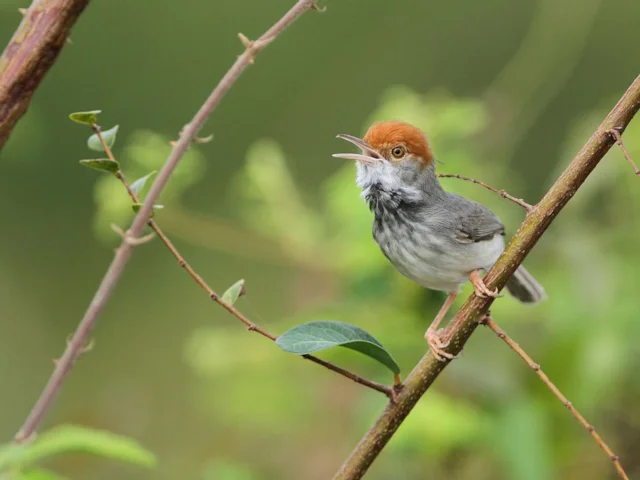New species hiding in plain sight
e1c81ecb-8379-4adc-b753-ae39b6618e77

A team of BirdLife International and World Conservation Society scientists have discovered a new species of tailorbird living in a capital city of 1.5 million people.
Cambodian Tailorbird Orthotomus chaktomuk, a previously undescribed species, was found in Cambodia’s urbanised capital Phnom Penh and several other locations just outside of the city, including a construction site. Scientists describe the new bird in a special online early-view issue of the Oriental Bird Club’s journal Forktail.
The grey wren-sized memeber of the Cisticolidae has a rufous cap and black throat, and lives in dense, humid lowland scrub in Phnom Penh and other sites on the floodplain. Its scientific species name chaktomuk is an old Khmer word meaning 'four-faces', perfectly describing the area centered in Phnom Penh where the Tonle Sap, Mekong and Bassac Rivers come together where the bird is found.
Only tiny fragments of floodplain scrub remain in Phnom Penh, but larger areas persist just outside the city limits where Cambodian Tailorbird is abundant. The authors say that the bird’s habitat is declining, and agricultural and urban expansion could further affect the bird and its habitat. BirdLife will assess the species’ conservation status for the Red List on behalf of the IUCN.
This same dense habitat is what kept the bird hidden for so long. Lead author Simon Mahood of the World Conservation Society (WCS) began investigating the new species when co-author Ashish John, also of WCS, took photographs of what was first thought to be a similar, coastal species of tailorbird, at a construction site on the edge of Phnom Penh. The bird in the photographs initially defied identification. Further investigation revealed that it had to be an entirely unknown species.
“The modern discovery of an undescribed bird species within the limits of a large populous city – not to mention 30 minutes from my home – is extraordinary,” said Mahood. “The discovery indicates that new species of birds may still be found in familiar and unexpected locations.”
The last two decades have seen a sharp increase in the number of new bird species emerging from Indochina, mostly due to exploration of remote areas. Newly described birds include babbler species from isolated mountains in Vietnam, the bizarre Bare-faced Bulbul from Lao PDR and Mekong Wagtail, first described in 2001 by WCS and other partners.
Co-author, BirdLife International's Jonathan Eames, said: “Most newly discovered bird species in recent years have proved to be threatened with extinction or of conservation concern, highlighting the crisis facing the planet’s biodiversity.”
Cambodian Tailorbird Orthotomus chaktomuk, a previously undescribed species, was found in Cambodia’s urbanised capital Phnom Penh and several other locations just outside of the city, including a construction site. Scientists describe the new bird in a special online early-view issue of the Oriental Bird Club’s journal Forktail.
The grey wren-sized memeber of the Cisticolidae has a rufous cap and black throat, and lives in dense, humid lowland scrub in Phnom Penh and other sites on the floodplain. Its scientific species name chaktomuk is an old Khmer word meaning 'four-faces', perfectly describing the area centered in Phnom Penh where the Tonle Sap, Mekong and Bassac Rivers come together where the bird is found.
Only tiny fragments of floodplain scrub remain in Phnom Penh, but larger areas persist just outside the city limits where Cambodian Tailorbird is abundant. The authors say that the bird’s habitat is declining, and agricultural and urban expansion could further affect the bird and its habitat. BirdLife will assess the species’ conservation status for the Red List on behalf of the IUCN.
 |
| Rear view of Cambodian Tailorbird. Photo: James Eaton. |
This same dense habitat is what kept the bird hidden for so long. Lead author Simon Mahood of the World Conservation Society (WCS) began investigating the new species when co-author Ashish John, also of WCS, took photographs of what was first thought to be a similar, coastal species of tailorbird, at a construction site on the edge of Phnom Penh. The bird in the photographs initially defied identification. Further investigation revealed that it had to be an entirely unknown species.
“The modern discovery of an undescribed bird species within the limits of a large populous city – not to mention 30 minutes from my home – is extraordinary,” said Mahood. “The discovery indicates that new species of birds may still be found in familiar and unexpected locations.”
The last two decades have seen a sharp increase in the number of new bird species emerging from Indochina, mostly due to exploration of remote areas. Newly described birds include babbler species from isolated mountains in Vietnam, the bizarre Bare-faced Bulbul from Lao PDR and Mekong Wagtail, first described in 2001 by WCS and other partners.
Co-author, BirdLife International's Jonathan Eames, said: “Most newly discovered bird species in recent years have proved to be threatened with extinction or of conservation concern, highlighting the crisis facing the planet’s biodiversity.”

